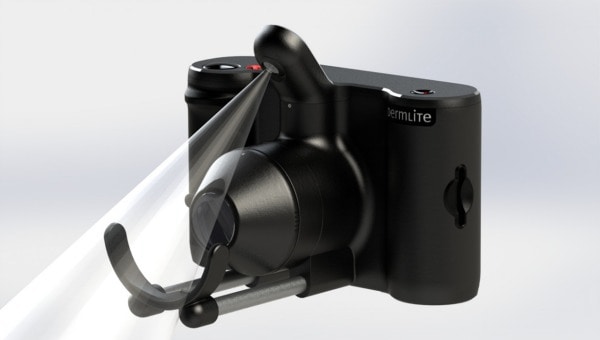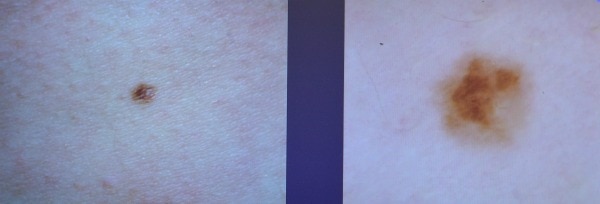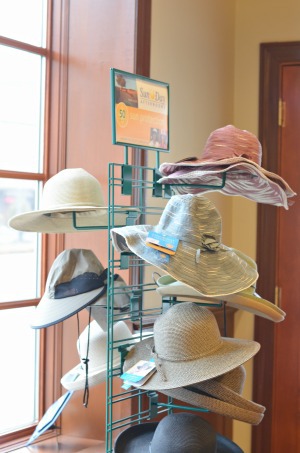
MoleSafe | How To Check Yourself For Skin Cancer
Last year I had a mole removed that was suspicious. I also had a mole biopsy in another area that was so invasive it never healed without looking hideous. It’s now dark and you can tell the dermatologist took way too much skin during the scalpel biopsy. It’s a scar that I’ll have forever. It was after that biopsy that I heard about MoleSafe. MoleSafe can safely check for melanomas and abnormalities without cutting. How do they do this? MoleSafe has a nurse who uses a special camera (MoleCam / Dermlite) to take dermoscopic images of the moles.

Then the images are sent over to physicians to view and access. Digital dermoscopy is not invasive and a safe option for anyone who wants to have their moles checked. The way it works is the camera can do high magnification + high light sensitivity to penetrate the first layer of skin and they’re able to see diagnostic features of moles that your dermatologist may not see with the naked eye. My dermatologist highly recommends MoleSafe and actually compares my spots with the spots that MoleSafe imaged. She recommends that I see MoleSafe once a year and her once a year – equaling 6 months between checks.

find a molesafe location
If you’re local to NJ/NY there’s locations in Millburn NJ, Paramus NJ, Freehold NJ, Garden City NY and New York NY,
They do a full body check or a spot check. The only downfall and I mean ONLY downfall is the pricing. Unfortunately insurance does not cover it, but they may reimburse you if you submit the claim. The investment is completely worth it if you have a family history of skin cancer or think you may be at risk. The good news is if you have any concerns within 12 months you can get those spots rechecked for free (up to 3 spots). The Dermatologists in the MoleSafe panel have been training for a minimum of 13 years.

During the imaging Maddie or whomever is taking pictures will tell you where to place your feet on this mat. This mat is designed so that you can pose in different positions for optimal view of moles in all areas. You will only wear underwear for this, just like at your dermatologist skin check.

Here’s one of my moles that my dermatologist has always worried about. This image from molesafe gives me piece of mind for my future checks with them as well as my dermatologist. We can detect any change that has occurred by comparing this image with future images, as well as my other images.

how to identify melanoma
The full results will be mailed to you, sent to your dermatologist/doctor and stored in the MoleSafe database. It’s a great way to keep record of your moles and full body skin checks.
MoleSafe | How To Check Yourself For Skin Cancer >> investment:
New Patients (up to 70 lesions imaged in select locations): $395
Existing Patients (select locations): $295
Spot Checks (select locations): $150-165
Since its establishment, MoleSafe has had more than 75,000 unique patients and 135,000 patient visits, with 1,500,000 lesions recorded and more than 2.8 million images. MoleSafe is the world’s most advanced early detection and surveillance program for melanoma that combines all of the current proven processes into one single program.
There’s no such thing as a safe tan. Recently there have been people saying “Get in the sun to boost your Vitamin D levels”. It’s a common misconception. If someone is tan they can still be deficient in Vitamin D. Even the Vitamin D Council is recommending going into the sun, then stating “Exposing your skin to the sun for too long, so that your skin starts to burn can be dangerous. This is because it can increase your risk of developing skin cancers. Research to date shows that moderate but frequent sun exposure is healthy but overexposure and intense exposure can increase your risk of skin cancer.” (source) Plus all these sites that say get “Safe sun exposure” do say you need full body exposure. Just arms and legs aren’t going to boost your levels by much.
Did you know? You still need sunblock in the winter. Just because you’re not sweating and instead freezing doesn’t mean those sun rays aren’t there. They are and you should definitely be protecting yourself.
In my opinion there’s no such thing as safe sun. I also don’t think that we should rely heavily on sunscreen alone protecting us as throughout the years there’s been some conflicting studies. Our family applies at least 30 SPF. Our daughter uses Badger Baby and we use Badger Unscented. In order to keep us fully protected we reapply every hour and a half. I found that I actually burn before the 2 hour reapply mark. Melanoma runs in my mother’s side so I take caution when it comes to the sun. I also try to sit in the shade whenever possible.
Another common misconception is that if you have darker skin you cannot get skin cancer. This is false. While you may not burn, you still can and possibly will get skin cancer in your lifetime. Just because your skin takes longer to burn isn’t a good indicator you’re not at risk for skin cancer. Your risk may be decreased, but isn’t nonexistent.
There’s safe ways to get Vitamin D:
- Vitamin D3 (other Vitamin D can be synthetic and we only recommend D3)
- Cod Liver Oil
- Fatty fish
- Beef liver
- Egg yolks
- Fortified milk and orange juice
- Fortified cereals (we eat organic/non gmo and have found there’s no added vitamins in ours)
MoleSafe | How To Check Yourself For Skin Cancer




The post MoleSafe | How To Check Yourself For Skin Cancer appeared first on Courtney's Sweets.